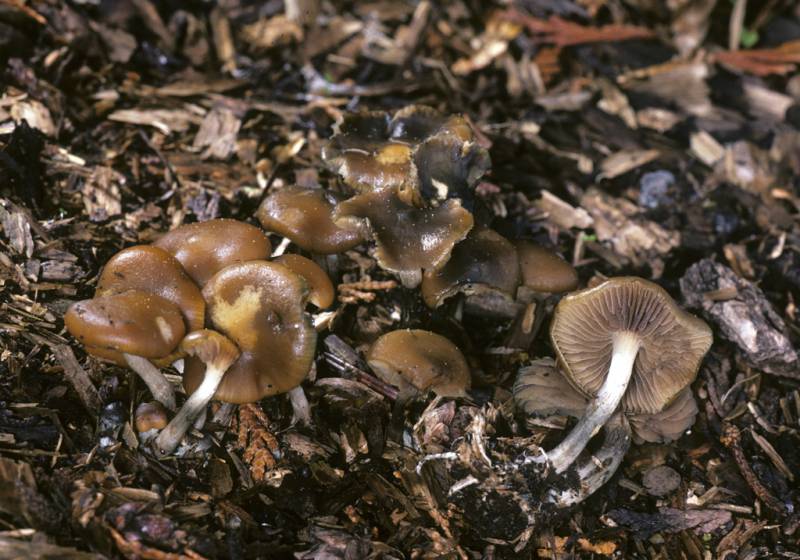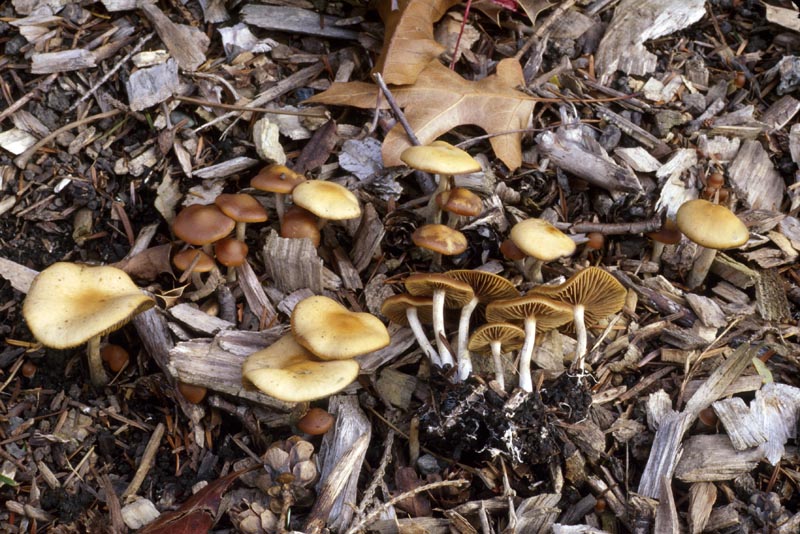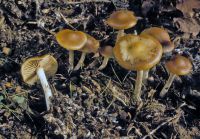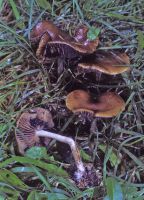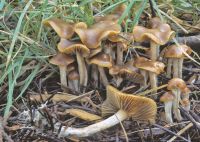Habitat: Several to many, in coniferous mulch
Spores: September-November
Conservation Status: Not of concern
Edibility: The blue staining indicates that it is one of the psychoactive species and it is generally considered to be at least moderately active.
blueleg brownie, cyans, blue halos, blueing psilocybe, potent psilocybe, wavy-capped psilocybe
Cap: 1.5-4 cm broad, soon convex to broadly convex, then plan or with an uplifted, often wavy margin; surface smooth, viscid when moist, dark brown or reddish-brown becoming caramel-brown, then fading as it dries to tan, yellowish-brown, or paler; sometimes with blue or blue-green stains, especially near margin. Flesh thin, bruising blue or blue-green. Gills typically adnate but sometimes seceding, fairly close, brown or cinnamon-brown becoming dark smoky brown or sometimes bluish-stained; edges whitish . Stalk: 3-8 cm long, 2-6 mm thick, equal or with an enlarged base, sometimes curved; dry whitish, but staining blue to bluish-green when handled or bruised. Veil: fibrillose or cobwebby, copious but disappearing or at most forming a very slight ring or hairy zone on stalk. Spore print: purple-brown to purple-gray or purple-black; spores 9-12 x 5-9 microns, elliptical, smooth. Chrysocystidia absent on gills.
The blue staining indicates that it is one of the psychoactive species and it is generally considered to be at least moderately active.
Psilocybe cyanescens is primarily a wood-chip dweller, being found in much the same locales as Stropharia aurantiaca and, like the latter species, becoming increasingly common, much to the delight of magic mushroom hunters. Normally it does not appear until relatively late in the season, typically around Halloween with the onset of cold weather. It is small, but fairly fleshy, with caramel-colored, viscid, hygrophanous caps with a wavy margin. The stipe is initially whitish, and both cap and stipe bruise blue when handled. The veil is fibrillose and rather heavy, but usually disappears without leaving much of a trace. It occurs in sometimes large groups, either singly or in small clusters.
Sources: Trudell, Steve and Joe Ammirati. Mushrooms of the Pacific Northwest. Portland, Timber Press, Inc. 2009. Lincoff, Gary. National Audubon Society Field Guide to North American Mushrooms. New York, Alfred A. Knopf, 1981. Arora, David. Mushrooms Demystified. Berkeley, Ten Speed Press, 1986.
PNW Herbaria: Specimen records of Psilocybe cyanescens in the Consortium of Pacific Northwest Herbaria database
CalPhotos: Psilocybe cyanescens photos

